

Great Video Tutorials on Creating Textbooks Using iBook Author. iBook Author is an awesome free app that allows users to easily create stunning multi-touch textbooks for iPad.

It provides all the tools one might need to start creating and publishing ebooks including galleries, video, interactive diagrams, 3D objects, and many more. iBook Author provides you with a set of pre-defined templates to help you design the background of your textbook. You can choose from a wide variety of styles, like classic textbook, or photo book in both landscape and portrait orientations. You can also choose from a variety of page layouts in each template, or even create one of your own. We Luv Garage Band and Apple TV. Our iPads were loaded with Garage Band this week, so my 6th grade students were able to begin creating the backing tracks for the raps they are composing.
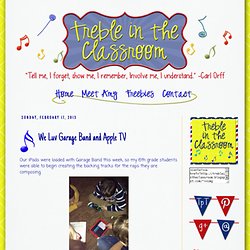
After learning about hip hop and rap, as well as listening to some examples of rap using the book, "Hip Hop Speaks to Children," I started the rap project by having students compose a repetitive chorus and three verses to alternate with the chorus. Math Projects. About Project-Based Learning Among the greatest benefits of project-based learning (PBL) are gains in students' critical-thinking skills and development of their interpersonal and intrapersonal skills.
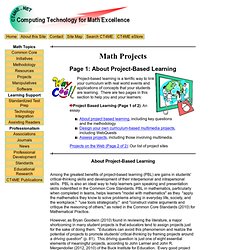
PBL is also an ideal way to help learners gain speaking and presentation skills indentified in the Common Core Standards. PBL in mathematics, particularly when completed in teams, helps learners "model with mathematics" as they "apply the mathematics they know to solve problems arising in everyday life, society, and the workplace," "use tools strategically," and "construct viable arguments and critique the reasoning of others," as noted in the Common Core Standards (2010) for Mathematical Practice. However, as Bryan Goodwin (2010) found in reviewing the literature, a major shortcoming in many student projects is that educators tend to assign projects just for the sake of doing them. What do we mean by building 21st century skills? Key Questions The Methodology Back to top. Resources for Project-Based Learning.
Last month we released Projects for all our education wikis.

Our intention was to give you a better tool for group work, but, as many of you have pointed out, they’re also great for project-based learning. Project-based learning, or PBL, grew out of early 20th century education reform, like the works of John Dewey. It generally involves directed, open-ended questions, real-life problem solving, and presentation to an authentic audience. And, of course, it’s a great way for students to build collaboration and 21st-century skills while mastering content. We’re really looking forward to hearing how you use PBL and the Projects feature in your classrooms. 8 Project-Based Learning Videos By Students - Getting Smart by John Hardison - edchat, EdTech, PBL.
A Few Tips for Projects & Presentations I have made many mistakes over the years when facilitating a project-based learning environment.
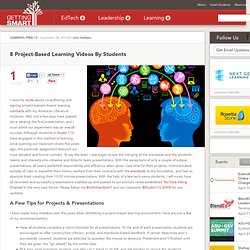
Here are just a few of my recommendations. Have all students complete a rubric/checklist for all presentations. At the end of each presentation, students are encouraged to offer constructive criticism, praise, and standards-based feedback. If certain objectives aren’t successfully covered, students are directed to question the misuse or absence. Below are a number of exemplary presentations from our recent American Literature Unit 1 PBL contracts. “I’m on a Boat” Musical Parody This team consisted of three, very busy softball players who effectively managed their extra-curricular responsibilities with their academic assignments. “I’m on a Boat” Complete Presentation Note the effective, standards-based delivery of their complete presentation. Project-Based Learning: Resources for Parents. Project-based learning can be a fantastic way for kids to get engaged in hands-on, active learning.
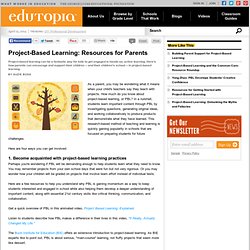
Here's how parents can encourage and support their children -- and their children's school -- in project-based learning. As a parent, you may be wondering what it means when your child's teachers say they teach with projects. Descriptive Statistics Project. Summary Unreviewed Activity submitted in preparation for the NNN Writing with Numbers Workshop Students choose a topic to investigate that they are interested in.
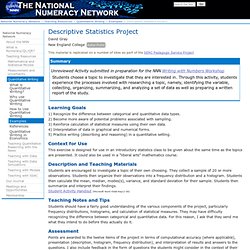
Through this activity, students experience the processes involved with researching a topic, namely, identifying the variable, collecting, organizing, summarizing, and analyzing a set of data as well as preparing a written report of the study. Learning Goals 1) Recognize the difference between categorical and quantitative data types. 2) Become more aware of potential problems associated with sampling. 3) Reinforce calculation of statistical measures using their own data. 4) Interpretation of data in graphical and numerical forms. 5) Practice writing (describing and reasoning) in a quantitative setting.
S BEST - Home. Internet Catalogue. Tech2learn.wikispaces.com/file/view/ProjectPlanningForms.pdf. Tech2Learn - Project-Based Learning. The following resource page was created by Brenda Sherry and Peter Skillen for PBL Teacher Workshops:
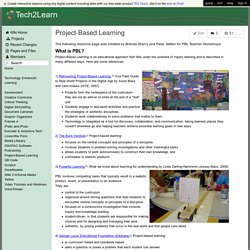
PBL Online Course - Home. Search Results. Project-Based Learning Professional Development Guide. An overview of the Edutopia professional development guide for teaching how to use project-based learning in the classroom.
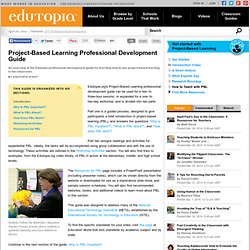
Edutopia.org's Project-Based Learning professional development guide can be used for a two- to three-hour session, or expanded for a one- to two-day workshop, and is divided into two parts. Part one is a guided process, designed to give participants a brief introduction to project-based learning (PBL), and answers the questions "Why is PBL important? ", "What is PBL about? ", and "How does PBL work? " Part two assigns readings and activities for experiential PBL. Students Follow the Butterflies' Migration: Teacher Frances Koontz shows students a symbolic butterfly sent from children in Mexico. The Resources for PBL page includes a PowerPoint presentation (including presenter notes), which can be shown directly from the website or downloaded for use as a stand-alone slide show, and sample session schedules.
Continue to the next section of the guide, Why Is PBL Important? PBL: Teaching Online. Personalize Learning with 20% Time. Personalized learning means that learning is centered around the students.

The students drive their learning around their passion, something they are interested in. Teachers guide the process. Sounds easy but it is a big shift in thinking for educators. Maybe the process can slowly evolve by transforming your classroom by using 20% of the time for passion-driven learning. Sir Ken Robinson said in an interview for the Vancouver Sun last week, “It isn’t that everyone has to learn different things, although eventually our interests will take us in different directions,” he continued. 20% Time at Google One concept Google is where employees work 80% of their time on Google projects and the other 20% of their time they can devote to any project they want.
Projects of Interest Brian Van Dyck (vandyck.brian@gmail) from Buchser Middle School in Santa Clara, California implemented 20% time in both his 6th grade Math class and 7th Grade Technology classes. What’s the Best Way to Practice Project Based Learning? By Peter Skillen Project Based Learning can mean different things to different people, and can be practiced in a variety of ways. For educators who want to dive in, the good news is that a rich trove of resources are available. In order to create your own definition and practice, here are some parameters to consider. This diagram, enhanced by the critical eye of Brenda Sherry, can help you figure out what’s important to you and your students.
We like to think with the frame of continua rather than dichotomies simply because things are rarely on or off, black or white, ones or zeroes. You could likely add other dimensions to consider as you build your own understandings and beliefs. How and why should math be taught using PBL? COACHES' CORNER | Telannia Norfar The following interview with Telannia Norfar, a member of BIE’s National Faculty and veteran high school math teacher, highlights the importance of utilizing Project Based Learning in math classes. This includes many of the key points made in her January 2012 webinar, which is archived on BIE's YouTube Channel. As a math teacher, what made you turn to Project Based Learning in your own teaching?
In my former careers in journalism, advertising, and telecommunications, I was always presented with new problems on almost a daily basis. I had to solve those problems with very little guidance from my supervisors. Modeling Health Insurance – Project Under Development. This past May, I was faced with a problem regarding health insurance. My employer offers two different plans, the Basic Plus Plan and the Premier. In the past, I was insured under the Premier plan with no cost to me. However, this summer I added my wife and child to my health insurance. I was faced with a decision. Should I cover my family under the Premier plan or change to family coverage under the Basic Plus Plan? The two plans are described in the summary plan (PDF). The out of pocket maximum for the Premier Plan is $6000 per year versus $12,000 per year for the Basic Plus Plan.The annual deductible for the Premier Plan is $600 per family versus $1200 per family for the Basic Plus Plan.In general, the Premier Plan covers 80% of medical charges and the Basic Plus Plan covers 60% of medical charges.
The plans differ in cost too. Inquiry Driven Instruction.